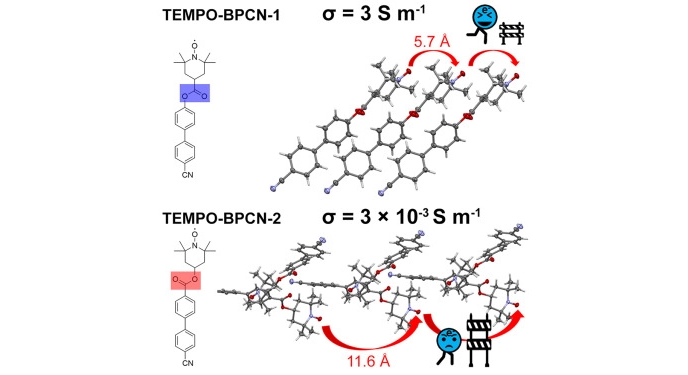ChE Researchers Create New Organic Crystals that Conduct Electricity.

 The new discovery came from a team of researchers led by Dr. Bryan Boudouris, Associate Vice President for Research and Professor of Chemical Engineering at Purdue University.
The new discovery came from a team of researchers led by Dr. Bryan Boudouris, Associate Vice President for Research and Professor of Chemical Engineering at Purdue University.
The team synthesized two organic molecules with very similar chemical structures, but they exhibited 1,000-fold difference in their electrical conductivities. By analyzing their crystal structures and conducting computational studies, the researchers explained the reason for such a huge discrepancy. The key to creating an electrical conducting organic crystal is to control the spatial arrangements of the radical species in a precise manner.
This discovery follows the long-supported hypothesis: subtle changes in nitroxide radical single crystal atomic connectivity drastically alter the macroscopic electronic properties of the material. This work is published in the May 17 issue of Cell Reports Physical Science titled, “Significant Charge Transport Effects Due to Subtle Molecular Changes in Nitroxide Radical Single Crystals.”
“Crystals are solid materials constituted by highly ordered atoms, molecules, or ions. Such highly ordered structures endow crystals with unique geometrical shape and stunning symmetry.” said lead researcher Zihao Liang. “When we think of crystals, images of beautiful and precious stones may pop into your mind, but people seldom think of these kinds of beautiful materials as electronic conductors. It is fascinating to see that a subtle molecular difference can finally lead to 1,000-fold difference in their electrical conductivities. Our research findings demonstrate the importance of the radical site arrangement on these material’s electrical conducting capabilities.”
 Zihao Liang is a Ph.D. Candidate in the Davidson School of Chemical Engineering. In addition to Liang and Boudouris, the paper was also authored by Sheng-Ning Hsu, Ying Tan, Hamas Tahir, Ho Joong Kim, Kangying Liu, Jacob Stoehr, Matthias Zeller, Letian Dou, and Brett Savoie.
Zihao Liang is a Ph.D. Candidate in the Davidson School of Chemical Engineering. In addition to Liang and Boudouris, the paper was also authored by Sheng-Ning Hsu, Ying Tan, Hamas Tahir, Ho Joong Kim, Kangying Liu, Jacob Stoehr, Matthias Zeller, Letian Dou, and Brett Savoie.
Read the full paper at https://www.cell.com/cell-reports-physical-science/fulltext/S2666-3864(23)00183-2
